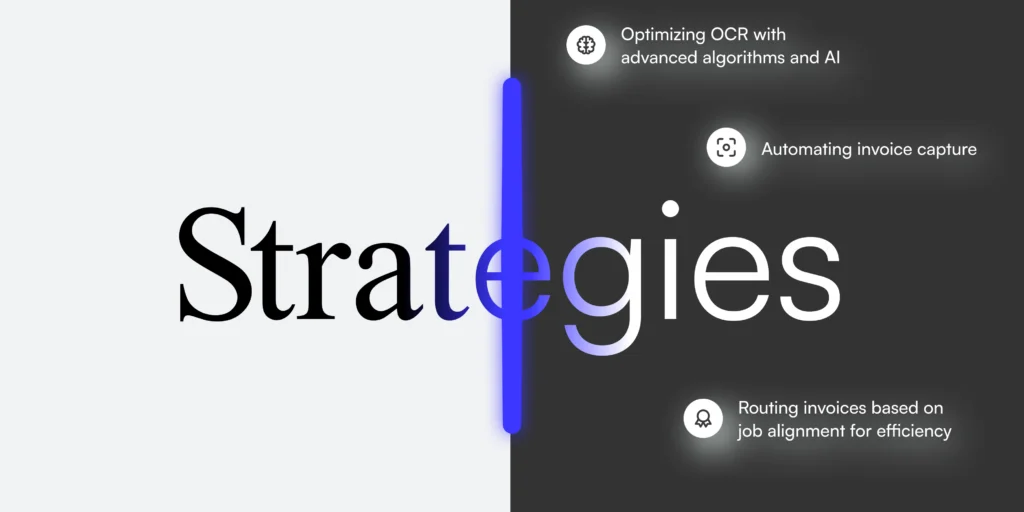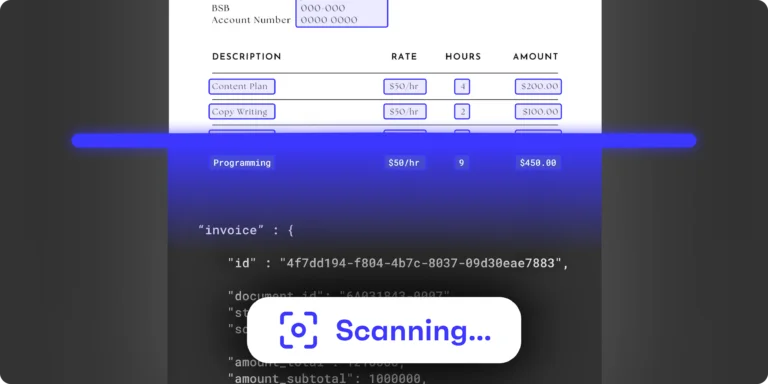The importance of OCR in Accounts Payable automation
Optical Character Recognition (OCR) technology is vital in automating Accounts Payable (AP) processes, transforming how companies handle invoice processing by converting diverse document types into editable and searchable data.
This technology’s significance is underscored by the fact that today, more than 60% of companies have embraced OCR tools to varying degrees within their accounts payable process. The implementation of this technology offers a multitude of benefits, elevating the efficiency and accuracy of accounts payable processes to new heights.
This blog discusses strategies to enhance OCR accuracy and speed in AP automation, with a particular focus on automating invoice capture and optimizing routing based on job alignment.
Understanding and using OCR technology in AP automation
OCR technology plays a critical role in AP automation, primarily used for extracting text from invoices and other financial documents. This technology excels in converting images of typed, handwritten, or printed text into machine-encoded text, which significantly streamlines the data entry process. By moving away from traditional manual methods, OCR-driven automation marks a substantial advancement in efficient invoice management.
Acting as the backbone of digital invoice processing, OCR technology scans and recognizes characters in documents, transforming them into digital formats. This process effectively eliminates the need for manual data entry, consequently reducing human errors and substantially boosting processing speed. Therefore, integrating OCR into AP systems is a pivotal step toward achieving enhanced operational efficiency and accuracy in financial transactions.
Key challenges in OCR accuracy and speed
Despite OCR’s advantages, several challenges can impede its performance. The most common issues include variability in document formats, low-quality images, and complex document layouts, which can significantly affect OCR’s accuracy and processing speed. Addressing these challenges is crucial for optimizing the efficiency of AP automation.
Strategies for enhancing OCR performance in AP systems
The path to enhancing OCR performance lies in a blend of technological advancements and strategic process optimization. Automation plays a pivotal role in this endeavor, offering significant improvements in both accuracy and speed. We discuss a couple of ways to improve:
- Automating invoice capture
One of the most effective strategies for improving OCR accuracy involves automating the invoice capture process. This entails developing systems capable of handling a broad spectrum of invoice formats and layouts, ensuring accurate data capture regardless of the document’s source. Automating invoice capture not only improves accuracy but also significantly reduces the time and resources spent on manual data processing.
- Optimizing OCR with advanced algorithms and AI
Another key strategy is the integration of advanced algorithms and Artificial Intelligence (AI) with OCR technology. AI models, when trained to recognize and interpret various invoice formats, provide a substantial boost to OCR’s capability. They enable the technology to adapt to different fonts, styles, and layouts, enhancing both the accuracy and efficiency of the OCR process in AP systems.
- Routing invoices based on job alignment for efficiency
Efficiently routing invoices based on job alignment further enhances the performance of OCR in AP systems. This strategy involves establishing rules within the AP system to automatically direct invoices to the appropriate department or personnel. The routing is determined based on job or project details captured by the OCR, thereby streamlining the approval and payment process.

The future of OCR technology in AP automation
Looking forward, the landscape of OCR technology in AP automation is set for significant advancements. The continued evolution of AI and machine learning promises OCR systems that are faster, more accurate, and highly adaptable to the dynamic needs of businesses.
However, building OCR technology from scratch is a complex and time-intensive endeavor. Developing an efficient OCR system requires substantial investment in machine learning and algorithm optimization. The accuracy and efficiency of the system improve progressively with use and refinement.
This ongoing development of OCR technology is critical, as it becomes an integral component of AP automation, driving efficiency and accuracy in financial operations. For many businesses, particularly those without extensive resources in machine learning and data processing, leveraging advanced OCR solutions developed by specialists like Monite is a strategic move. This approach bypasses the complexities of building from scratch while gaining access to cutting-edge technology.
Conclusion
OCR is nowadays a critical element in AP automation, expected by modern businesses for its efficiency. However, crafting a high-performance OCR system, particularly for industries with complex needs like construction, is challenging and resource-intensive.
Choosing a ready-made, customizable OCR infrastructure is a strategic move. It not only saves development time but also provides access to expertise that’s otherwise almost impossible to recruit for. This approach allows B2B platforms to focus on core activities while leveraging expert solutions to help build their Bill Pay products, ensuring efficiency, accuracy, and scalability.
For more insights on implementing advanced OCR technology for your AP product, read the possibilities of building on top of infrastructure for Accounts Payable.
